Better Results from Paid Media for Fintech
How we took a B2C financial services provider from the automated bid “death spiral” to unprecedented growth through paid media for fintech
Automated bidding had put them into the “death spiral”: impressions, clicks, and conversions were all down by at least 33%, and revenue was down 42%
Hands-on, detail-oriented account management, adjusting keywords for more targeted traffic, and improving ad copy and quality scores for cumulative savings of $630,000
A financial services provider specializing in online bill paying approached us for help with their paid search advertising. They had been managing their account using automated bid management tools, but the results were alarming.
They were caught in the “death spiral” of paid search. Automatic bidding had lowered their bids, and thus their impressions, clicks, and conversions. In the past three months, they had seen:
- 33% drop in impressions
- 35% drop in clicks
- 38% drop in conversions
- 42% drop in revenue
The Danger of Automated Bid Management
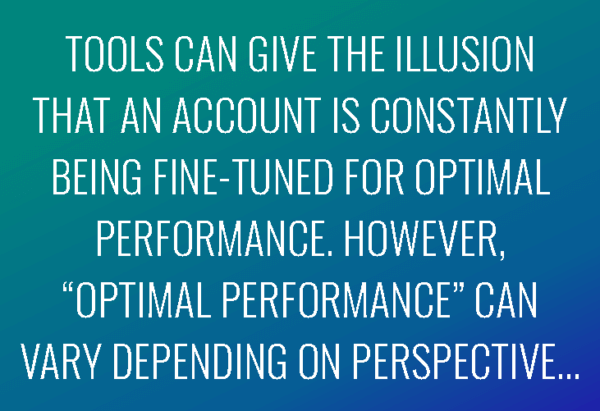 Automated tools can be very appealing. Some of them are built into a paid search platform, making them extremely convenient, especially for an in-house team that might not have much expertise in the details of account management or the budget to screen tools and purchase one or more.
Automated tools can be very appealing. Some of them are built into a paid search platform, making them extremely convenient, especially for an in-house team that might not have much expertise in the details of account management or the budget to screen tools and purchase one or more.
Tools can give the illusion of oversight and efficiency, making it look like an account is constantly being adjusted and fine-tuned for optimal performance. However, “optimal performance” can vary depending on the perspective from which it is evaluated.
- It’s in a client company’s best interest to optimize performance toward bottom-line metrics such as conversions, revenue, and cost per conversion
- Without initial adjustment and constant management, a tool could optimize based on non-revenue-related metrics such as average ad position, total spend (rather than cost per conversion), or click-through rate
- Without strong, detail-oriented oversight to harness bid adjustment tools, they could make changes that completely undercut bottom-line performance
We don’t make a policy of avoiding tools; on the contrary, we use many of them to optimize our clients’ paid search activities. However, we vet each tool we use very carefully, and only use it to the extent that it makes us more efficient in carrying out the strategies and tactics we’ve designed for our clients.
In this client’s case, over-reliance on automated bid management tools had caused these problems:
- High-volume keywords had been paused, severely limiting traffic and thus conversion opportunities
- Because keywords couldn’t be reenabled automatically, these high-volume terms stayed paused, exacerbating the effects of lowered traffic
- Target costs per conversions had been lowered so many times that for a significant number of keywords, bidding high enough to get an ad visible on a search engine results page was essentially impossible
Automated bid management, intended to boost efficiency, had instead torpedoed performance and harmed the company’s bottom line. Fortunately, they contacted us before any more damage could be done.
Plan for Improvement
Ordinarily, our strategic plans have three phases:
- Phase 1 delivers short-term fixes with visible results in less than 1-2 months
- Phase 2 rebuilds the client’s paid search account during months 3-6
- Phase 3 expands the reach, power, and capacity of the client’s paid search by testing new channels, including remarketing and mobile
However, this client’s accounts were complex and included dozens of individual billers, each with different data-gathering methods. So we folded Phases 1 and 2 together, improving and rebuilding campaigns on a per-biller basis over the next 8 months.
More than five years after the start of our engagement, Phase 3 is still ongoing because optimization never truly stops.
Immediate Fixes
During the first phase of our engagement, we used a triage approach: fixing what needed to be fixed to stabilize the account and making simple improvements that yielded significant returns.
Stabilize the account: manual bidding & optimization
The first, and most important, thing we did was to change all campaigns from automated bid management to manual bid management and optimization. By doing this, we took control from the platform’s algorithm and gave it to our paid search experts, who combined their expertise with our mission to improve our clients’ returns and revenue – not those of the platform.
Deliver quick results: keywords
The client’s keyword approach was counterproductive to attracting high-value searchers:
- High-volume, relevant keywords had been paused or deleted
- Some keywords strongly related to business goals had been marked as negative
- Many ad groups had duplicate keywords
- Not enough negative keywords were used to weed out non-relevant searches
By fixing all these keyword issues, we refocused the account toward better searcher intent to increase traffic, conversions, and revenue.
Phase 1 & 2 Results
Our engagement with the company began in May 2012. By December, we delivered these improvements compared to the first 4 months of 2012:
- 181% increase in conversions
- 275% increase in conversion rate (CVR)
- 68% reduction in cost per conversion
- 10% reduction in average weekly spend
- 193% increase in average weekly revenue
- 224% increase in return on advertising spend (ROAS)

Phase 3: Testing New Channels
After we had fully rebuilt the client’s Google account and demonstrated consistently improving performance, the client gave us additional budget to add new channels. We began by adding Bing as a paid search channel in the second year, then added Yahoo Gemini in the third year.
As we do with every channel, we customized:
- Ad copy
- Keyword choice
- Bid settings and strategies
Bing results
Because of our attention to detail when we added Bing and set up its account and campaigns, we saw gradual results that made a big difference over time. Over the next 6 quarters:
- Conversion volume had more than doubled, reaching nearly 160,000 per quarter
- By the end of Q4 2014, Bing was contributing almost as many conversions as Google: 21,046 to Google’s 22,929
Bing has delivered consistently high-dollar conversions; except for one period in mid-2014, its revenue-to-conversion ratio (the Value Ratio) has been 1.00 or greater.
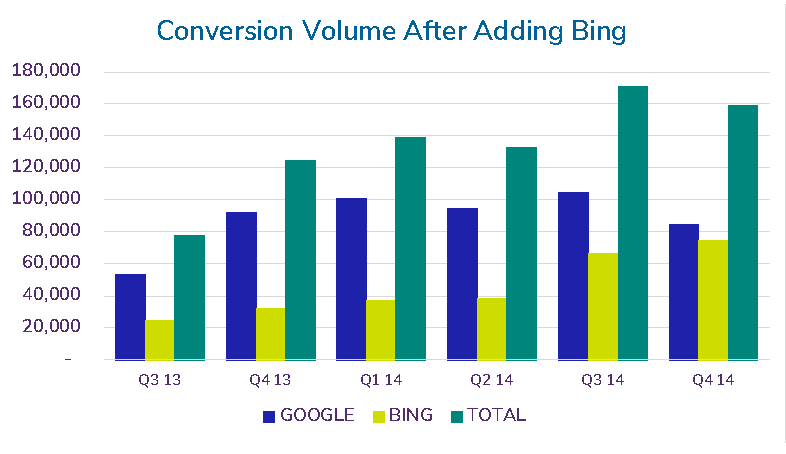
Yahoo results
Adding Yahoo in January 2015 further expanded our client’s reach. Like Bing, Yahoo has more female users than male. As more than 65% of household bills are paid by women, Yahoo was a logical choice for our third channel.
Yahoo Gemini hasn’t historically added a great deal of conversion volume. However, its cost per conversion is comparable to both Google and Bing, and its cost per click is much lower.
Additionally, like Bing, Yahoo Gemini’s relative value per conversion has been higher than .99 for 18 months now.
Google is still the channel of choice for volume, but these other channels reach the client’s target audiences more efficiently and deliver proportionally more revenue.
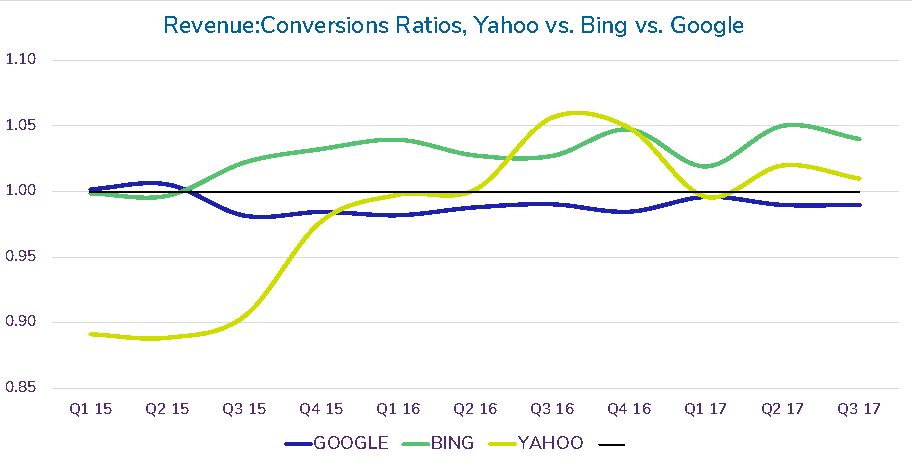
Phase 3: Mobile
We determined that mobile would probably be a strong channel for our client because of its existing presence in their industry. For instance, according to research conducted by the Pew Charitable Trusts, by 2014, one-third of U.S. adults had used a mobile device to pay a bill.
We introduced Google Calls and Bing Calls in Q2 of 2014, and both channels performed consistently well. The client increased their investment in mobile in 2017, leading to even greater gains. By the end of Q3 2017, mobile was responsible for nearly 30% of total revenue and total conversions.

Phase 3: Quality Score
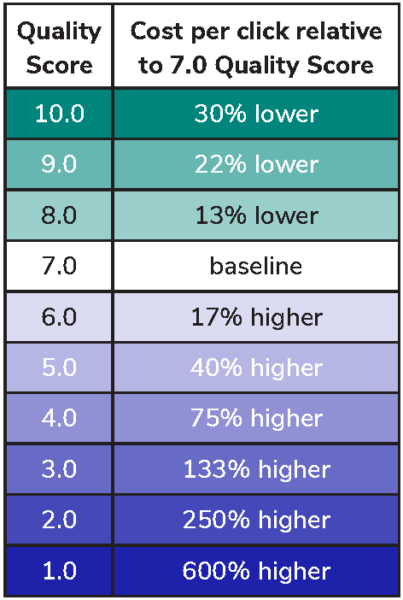 One often-overlooked aspect of paid search is Quality Score, the numeric value a search engine assigns to a keyword based on how well a client’s ads adhere to best practices. For all three major search engines, Quality Score is rated on a scale of 1 to 10 and comprised of these criteria:
One often-overlooked aspect of paid search is Quality Score, the numeric value a search engine assigns to a keyword based on how well a client’s ads adhere to best practices. For all three major search engines, Quality Score is rated on a scale of 1 to 10 and comprised of these criteria:
- Relevance to searcher intent
- Expected click-through rate
- Landing page experience
Of course, higher-quality ads will result in more visibility, targeted traffic, and conversions. However, a higher Quality Score will also result in a lower cost-per-click bid, as search engines discount CPC bids for scores over 7.0 and increase bid costs for scores lower than 7.0 (ads scoring 7.0 receive no discount or inflation).
Our client had re-written or re-introduced ad copy many times in the months prior to our engagement with them, so many Quality Scores were reset to 7.0. Thus, the average of all their scores was 7.1.
Quality Score results
Over the next 5 years, we brought their average Quality Score up from 7.1 to 9.0. Not only did the high-quality keywords deliver more relevant traffic to the client’s site, the increase in Quality Score resulted in significant savings.
- By the end of 2017, monthly savings averaged around $28,000
- As of Q4 2017, we have saved the client a total of $629,557 in costs per click alone
- Quality Score improvements saved the client $339,626 in 2017 itself
No automated tool could deliver these improvements in Quality Score; that requires human intelligence, experience, and insight, as well as the diligence to keep improving ad copy and landing pages.
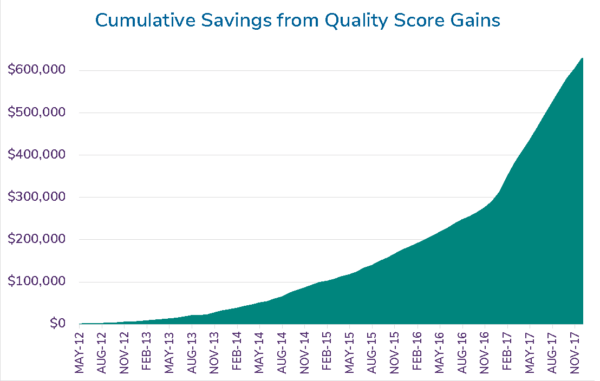
Overall Results
Not only did we get our client out of the “death spiral” in less than a year, we built a strong foundation for growth. We improved every metric: conversion volume, conversion rate, cost per conversion, return on advertising spend, and revenue.
From the start of our engagement to the end of 2017, we have achieved these results:
- 1,495% increase in weekly conversion volume
- 417% increase in conversion rate
- Cost per conversion reduced by 78%
- Weekly revenue increased by 1,789% while weekly ad spend increased by 258%
- 431% increase in return on advertising spend
For 2016, we set a goal with the client of earning $2.1M in revenue by the end of the year. We exceeded that goal by $134,000. And in 2017, we more than doubled it, with a revenue of $4.96M.

When our client approached us, they had entered the death spiral of automated bid tools: as costs-per-conversion were automatically bid lower and lower, the company was losing more and more visibility, traffic, conversions, and revenue.
We immediately assumed manual control of their accounts and began applying our expertise, insight, and attention to detail. We adjusted and optimized their bid strategy, and achieved an astonishing turnaround by the end of that year.
In the next few years, we added more channels based on research into the client’s target market, their bill-paying behavior and their search engine usage habits. We expanded into mobile advertising and saw significant results from that channel.
Throughout our engagement, we have increased their ads’ average Quality Score so much that they’re now saving almost $30,000 a month in bids and getting a much better return on their investment in paid search.
Takeaways
The steady growth we’ve produced for our client didn’t come from a one-size-fits-all approach or a hands-off style of just adjusting some campaign settings and monitoring the results. Instead, they’re a natural development from our philosophy regarding digital marketing, especially these aspects:
Autopilot is not an option
If you let a tool or platform control your search marketing, it’s bound to make decisions about your spend that won’t benefit you. It’s always best to have human intelligence in charge.
Focus on Quality Score
The higher your ads’ Quality Score, the lower your cost per click. Plus, higher-quality ads attract higher-quality traffic, leading to more conversions and revenue from fewer clicks. A high Quality Score is key to maximizing your return on advertising spend.
Always be testing and optimizing
Never settle for “good enough” or “what worked before.” Keep seeking ways to improve performance, remove friction from the buying process, and introduce beneficial innovations.

